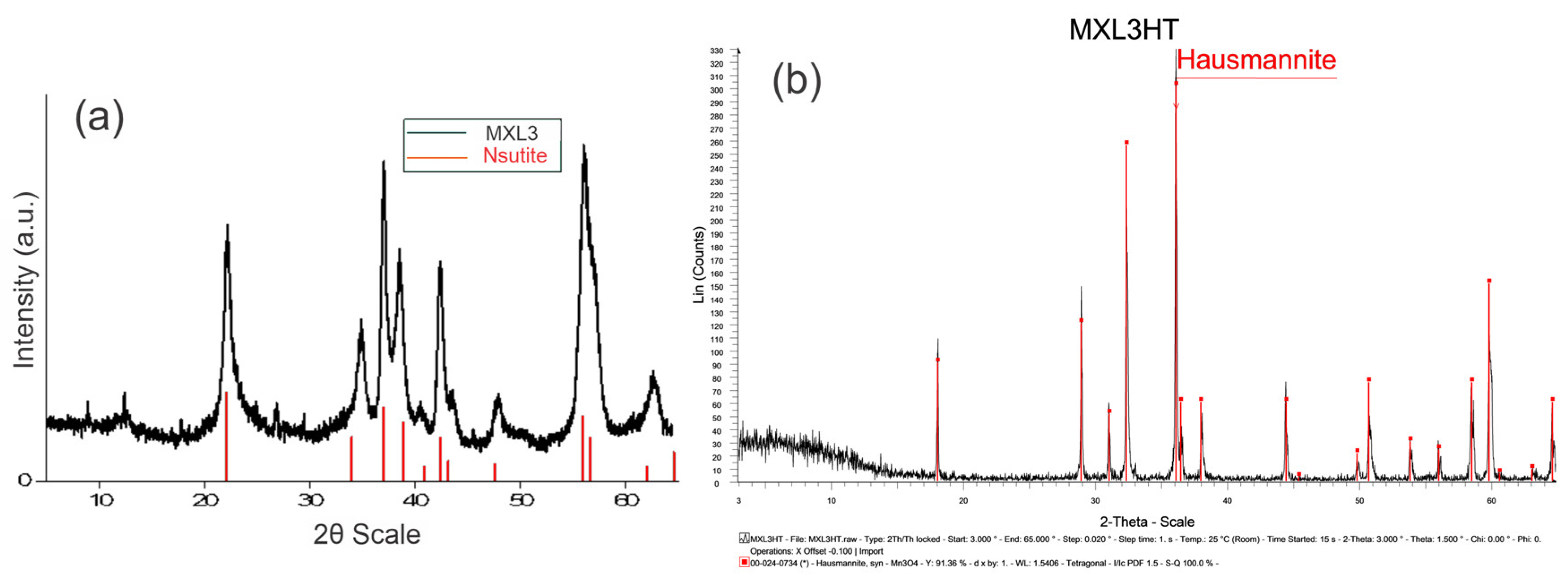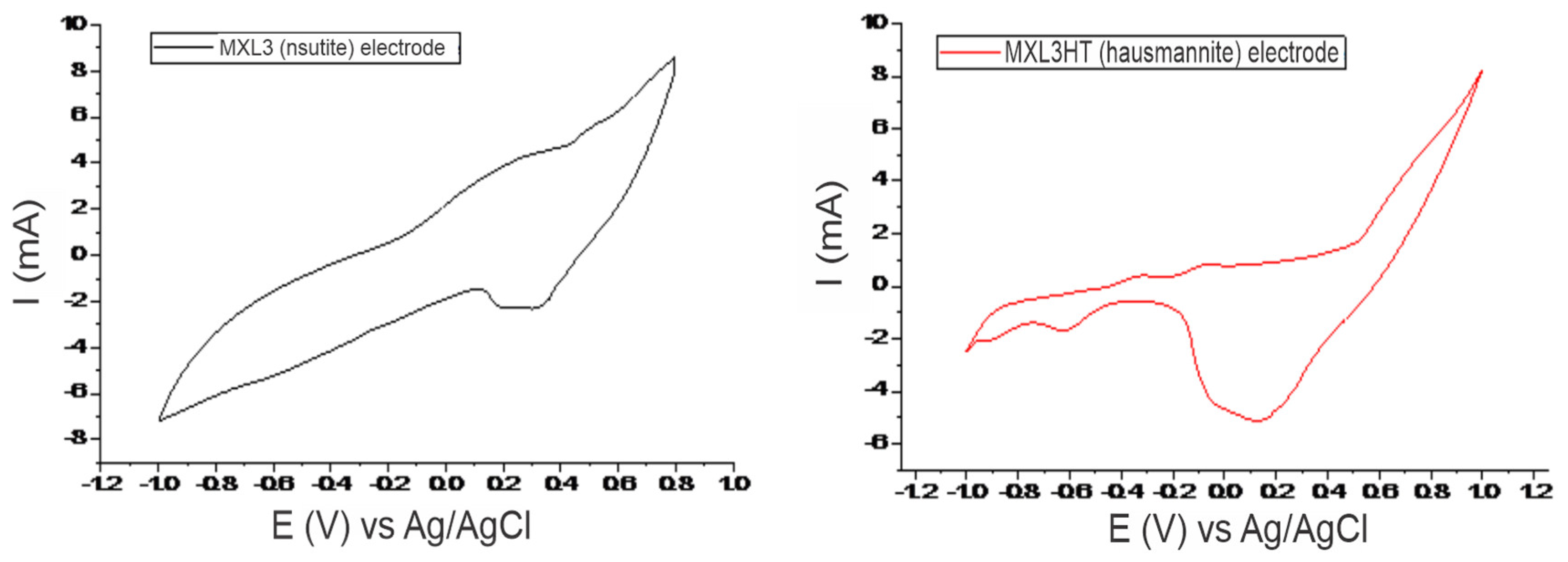Structural and Electrochemical Characterization of Natural Manganese Oxides for Energy Storage Applications †
Abstract
:1. Introduction
2. Materials and Methods
3. Results
3.1. Mineralogical and Structural Characterization
3.2. Electrochemical Characterization
4. Conclusions
Author Contributions
Funding
Institutional Review Board Statement
Informed Consent Statement
Data Availability Statement
Acknowledgments
Conflicts of Interest
References
- Ghosh, S. Diversity in the Family of Manganese Oxides at the Nanoscale: From Fundamentals to Applications. ACS Omega 2020, 5, 25493–25504. [Google Scholar] [CrossRef] [PubMed]
- Rout, K.; Mohapatra, M.; Mohapatra, B.K.; Anand, S. Pb(II), Cd(II) and Zn(II) adsorption on low grade manganese ore. Int. J. Eng. Sci. Technol. 2009, 1, 106–122. [Google Scholar]
- Nguyen, T.Q.; Loganathan, P.; Nguyen, T.V.; Vigneswaran, S. Removing arsenic from water with an original and modified natural manganese oxide ore: Batch kinetic and equilibrium adsorption studies. Environ. Sci. Pollut. Res. 2020, 27, 5490–5502. [Google Scholar] [CrossRef] [PubMed]
- Thackeray, M. Manganese oxides for lithium batteries. Prog. Solid State Chem. 1997, 25, 1–71. [Google Scholar] [CrossRef]
- Post, J. Manganese oxide minerals: Crystal structures and economic and environmental significance. Proc. Natl. Acad. Sci. USA 1999, 96, 3447–3454. [Google Scholar] [CrossRef] [PubMed]
- Gomes-Pimentel, M.; da Silva, M.R.C.; Viveiros, D.C.S.; Picanço, M.S. Manganese mining waste as a novel supplementary material in Portland cement. Mater. Lett. 2022, 309, 131459. [Google Scholar] [CrossRef]
- Darmane, Y.; Cherkaoui, M.; Kitane, S.; Alaoui, A.; Sebban, A.; Touhami, M.E. Preparation of chemical manganese dioxide from Moroccan pyrolusite mine waste. Hydrometallurgy 2008, 92, 73–78. [Google Scholar] [CrossRef]
- Mendes, K.C.; Figueira, B.A.M.; Lavra, T.C.C.; Fernandez, O.J.C.; Gómez, P.C.; Mercury, J.M.R. Hydrothermal synthesis of o-LiMnO2 employing Mn mining residues from Amazon (Brazil) as starting material. Mater. Lett. X 2019, 2, 100012. [Google Scholar] [CrossRef]
- Stosevski, I.; Bonakdarpour, A.; Fang, B.; Voon, S.; Wilkinson, D. Hausmannite Mn3O4 as a positive active electrode material for rechargeable aqueous Mn-oxide/Zn batteries. Int. J. Energy Res. 2021, 45, 220–230. [Google Scholar] [CrossRef]
- Chabre, Y.; Pannetier, J. Structural and Electrochemical Properties of the proton/γ–MnO2 system. Prog. Solid State Chem. 1995, 23, 1–130. [Google Scholar] [CrossRef]
- Gowda, C.; Mathur, A.; Parui, A.; Kumbhakar, P.; Pandey, P.; Sharma, S.; Chandra, A.; Singh, A.; Halder, A.; Tiwary, C. Understanding the electrocatalysis OER and ORR activity of ultrathin spinel Mn3O4. J. Ind. Eng. Chem. 2022, 113, 153–160. [Google Scholar] [CrossRef]
- Sahoo, R.; Pham, D.; Lee, T.; Luu, T.; Seok, J.; Lee, Y. Redox-Driven Route for Widening Voltage Window in Asymmetric Supercapacitor. ACS Nano 2018, 12, 8494–8505. [Google Scholar] [CrossRef] [PubMed]


Disclaimer/Publisher’s Note: The statements, opinions and data contained in all publications are solely those of the individual author(s) and contributor(s) and not of MDPI and/or the editor(s). MDPI and/or the editor(s) disclaim responsibility for any injury to people or property resulting from any ideas, methods, instructions or products referred to in the content. |
© 2023 by the authors. Licensee MDPI, Basel, Switzerland. This article is an open access article distributed under the terms and conditions of the Creative Commons Attribution (CC BY) license (https://creativecommons.org/licenses/by/4.0/).
Share and Cite
Soulamidis, G.; Stouraiti, C.; Kourmousi, M.; Tzevelekidis, P.; Charalampous, E.; Mitsopoulou, C.A. Structural and Electrochemical Characterization of Natural Manganese Oxides for Energy Storage Applications. Mater. Proc. 2023, 15, 64. https://doi.org/10.3390/materproc2023015064
Soulamidis G, Stouraiti C, Kourmousi M, Tzevelekidis P, Charalampous E, Mitsopoulou CA. Structural and Electrochemical Characterization of Natural Manganese Oxides for Energy Storage Applications. Materials Proceedings. 2023; 15(1):64. https://doi.org/10.3390/materproc2023015064
Chicago/Turabian StyleSoulamidis, George, Christina Stouraiti, Maria Kourmousi, Panagiotis Tzevelekidis, Eleni Charalampous, and Christiana A. Mitsopoulou. 2023. "Structural and Electrochemical Characterization of Natural Manganese Oxides for Energy Storage Applications" Materials Proceedings 15, no. 1: 64. https://doi.org/10.3390/materproc2023015064
APA StyleSoulamidis, G., Stouraiti, C., Kourmousi, M., Tzevelekidis, P., Charalampous, E., & Mitsopoulou, C. A. (2023). Structural and Electrochemical Characterization of Natural Manganese Oxides for Energy Storage Applications. Materials Proceedings, 15(1), 64. https://doi.org/10.3390/materproc2023015064






